




President Howard Mendel
Chairman
Peter Maddison
Barnmead, Fishpond Rd, Waldringfield, Woodbridge IP12 4QX Tel: 01473 736607 email: prmaddison@yahoo.co.uk
Membership Secretary Liz Cutting Tel: 01206 394184 Email: cutting.liz@yahoo.com
Treasurer
Kevin Ling email: kevling2013@aol.com
Secretary
Julian Dowding 84, Clapgate Lane, Ipswich IP3 0RE Tel: 01473 436096 email: julian.dowding@ntlworld.com
County Butterfly Recorder
James Corton email: suffolkbutterflyrecorder@gmail.com
Transect and WCBS Co-ordinator Twm Wade email: twm.wade@ yahoo.com
Conservation Officer (Butterflies) To be appointed
County Moth Recorder
Neil Sherman email: moth@sns.org.uk
Committee Members
David Dowding
Matt Berry email: matt@greenwings.co.uk
Mark Brewster Email: mark.ian.brewster@gmail.com
Website
Richard Perryman email: richard.perryman@ntlworld.com
Newsletter Editor
Trevor Goodfellow email: trevor@greenfarm.org.uk
Regional Officer, Eastern England
Sharon Hearle
Tel: 01638 484145 email: shearle@butterfly-conservation.org
Associate Committee Members
Nigel Hannay John Lepley
The Suffolk Argus is published by the Suffolk Branch of Butterfly Conservation. The opinions expressed in this newsletter are not necessarily those of Butterfly Conservation or the Branch. © 2022 All rights reserved. For more information, see: www.suffolkbutterflies.org.uk
Butterfly Conservation Company limited by guarantee, registered in England (2206468) Registered Office: Manor Yard, East Lulworth, Wareham, Dorset, BH20 5QP Charity registered in England & Wales (254937) and in Scotland (SCO39268)
Trevor Goodfellow
I hope you all survived this summer’s heatwave, COVID, fuel prices, cost of living hike, war, Boris, etc. and found relief by chasing butterflies.
Purple hairstreaks seemed to be drawn down during the hot weather. Perhaps due to the lack of aphid honeydew in the upper branches (see Heat Effect Observations page 6 & 24).
It remains to be seen whether the figures support it, but it did feel like a poor year for first brood Brown Argus and Common blue. However, second broods did better, and I did see more White-letter hairstreaks than last year, so fingers crossed that at least some species did well.
During the Summer I was asked several times about identifying some species, so I created a short guide (see back page) which I hope helps those novice members and others who are unsure.
Lots of people emailed me with sightings of Clouded yellow and Humming-bird hawk moths, which was great to hear and thanks for contacting me.
Thanks also to Emma Aldous for scanning and digitising all the hard copies of The Suffolk Argus from volume 1, you can now view all previous Suffolk Argus volumes (1-83) online here: www.suffolkbis.org.uk/publications/ suffolk-argus
Plus, Paul Douch has created an index for all newsletters which is now available on our website, this enables the reader to easily search
all issues for species, author, site, or whatever info you are looking for. The SBIS site has a search facility too, for all issues, alongside ‘White Admiral’ and ‘The Harrier’ and other publications. Thanks, Paul, for donating your time.
As we near the end of 2022, I cannot believe that it will soon be 2023, it seems strange just writing it!
I remind you that The Suffolk Argus is a newsletter for all Suffolk Butterfly Conservation members so please try to find time to tell me what you have seen or done that might be of interest. The committee works hard to organise and run events to raise funds and spread the word for Butterfly Conservation and as my name appears ever more frequently here, it risks becoming more like my diary than a members’ newsletter so please help however you can.
For the Spring Argus I am planning a gallery of aberrations so if you have photographed any unusual specimens, please email them to me at trevor@greenfarm.org.uk together with details like where and when you found them. I will try to identify the aberrations if you cannot.
Copy date for the Spring edition is January 30th 2023.
Long live the King.
(Cover photo of Duke of Burgundy by Kev Ling)
BC Suffolk are volunteering at Purdis Heath SSSI, Ipswich for the Silver-studded Blue. If you would like to help us, please get in touch with me, the Purdis site warden.
We will be opening up flight areas (removal of scrub) and doing light weeding on breeding areas.
Work-parties will take place on the last Saturdays of the remaining months of the year, 10am until 3pm.
Editor. Source: BBC Radio 4 and NBC online
California’s Pacific coast saw a massive decline in wintering Western Monarch butterflies in 2021. An annual winter count returned just 2,000 indicating a massive decline of 99.9% from the usual tens of thousands. This year’s count started 3 weeks early and has already returned 50,000!
In ‘Butterfly Town’ near San Francisco, there were no sightings last year, but this year 13,000 so far. A quote heard on the radio when a local businessman was interviewed from a company sporting a Monarch as their logo, was asked what he thought of the decline in the beautiful orange and brown
butterfly, he replied ‘if we don’t see them anymore, I might have to change my logo’.
This might seem like a recovery but obviously signals climate change taking its toll along with destruction of milkweed plants which they solely rely on as their larval foodplant. The long-term state is unpredictable but at least a $1,000 fine has been set for anyone messing with the monarch’s wellbeing. The recent Californian droughts may be a factor which has reduced the amount of available nectar sources and interferes with the success of the Monarchs’ 3,000 mile migration.
Editor (Interpreted from BES Journal of Animal Ecology 2017).
Temperature extremes were found to be the main driver of Butterfly population changes. Previously undocumented detrimental effects were also identified for extreme precipitation during the pupal life stage for univoltine (single brood) species. Generalists were found to have significantly more negative associations with extreme climatic events (ECEs) than specialists.
With future projections of warmer, wetter winters and more severe weather events, UK butterflies could come under severe pressure given the findings of this study.
Extreme heat during overwintering periods was detrimental to both univoltine and
multivoltine (more than one brood) species and during Summer periods beneficial. Extreme cold had the opposite impact on both pupal and adult life stages. Also, detrimental effects were identified for extreme precipitation during the pupal life stage for univoltine species (single brood). Generalists were found to have significantly more negative associations with ECEs than specialists.
Multivoltine species:
Extreme heat during overwintering and extreme precipitation during first- and second-generation adult life stages are the most frequently occurring extreme
variables causing population declines (58% and 50% resp.) As in univoltine species, adult and overwintering life stages have opposite population responses to temperature extremes. Extreme heat during the adult life stage is associated with positive population change in 42% of species. Drought plays a much more important role in multivoltine species than in univoltine species. Drought negatively affects 50% of species during their second larval life stage but has a positive impact on 25% of the species during their first ovum life stage. In the model combining all multivoltine species, the nine most important variables account for 73% of the predictive power of the combined multivoltine model. The multivoltine model is clearly driven by extremes of temperature; five were extremes in heat and one a cold
extreme. Unlike univoltine species however, multivoltine species seem to be susceptible across all life stages, with ovum, larvae, pupae, adult and overwintering all being represented in the nine most important variables in the combined model. Species’ vulnerability to extremes appears to be most prominent in the first generation and is primarily driven by exposure to extreme heat with the exception of the negative impacts of precipitation during the adult stage. (www.besjournals.onlinelibrary.wiley.com for further reading and clarifying the above details)
The Small Tortoiseshell population crash could be attributed at least in part, to milder wetter winters which affect more so, those hibernating as adults.

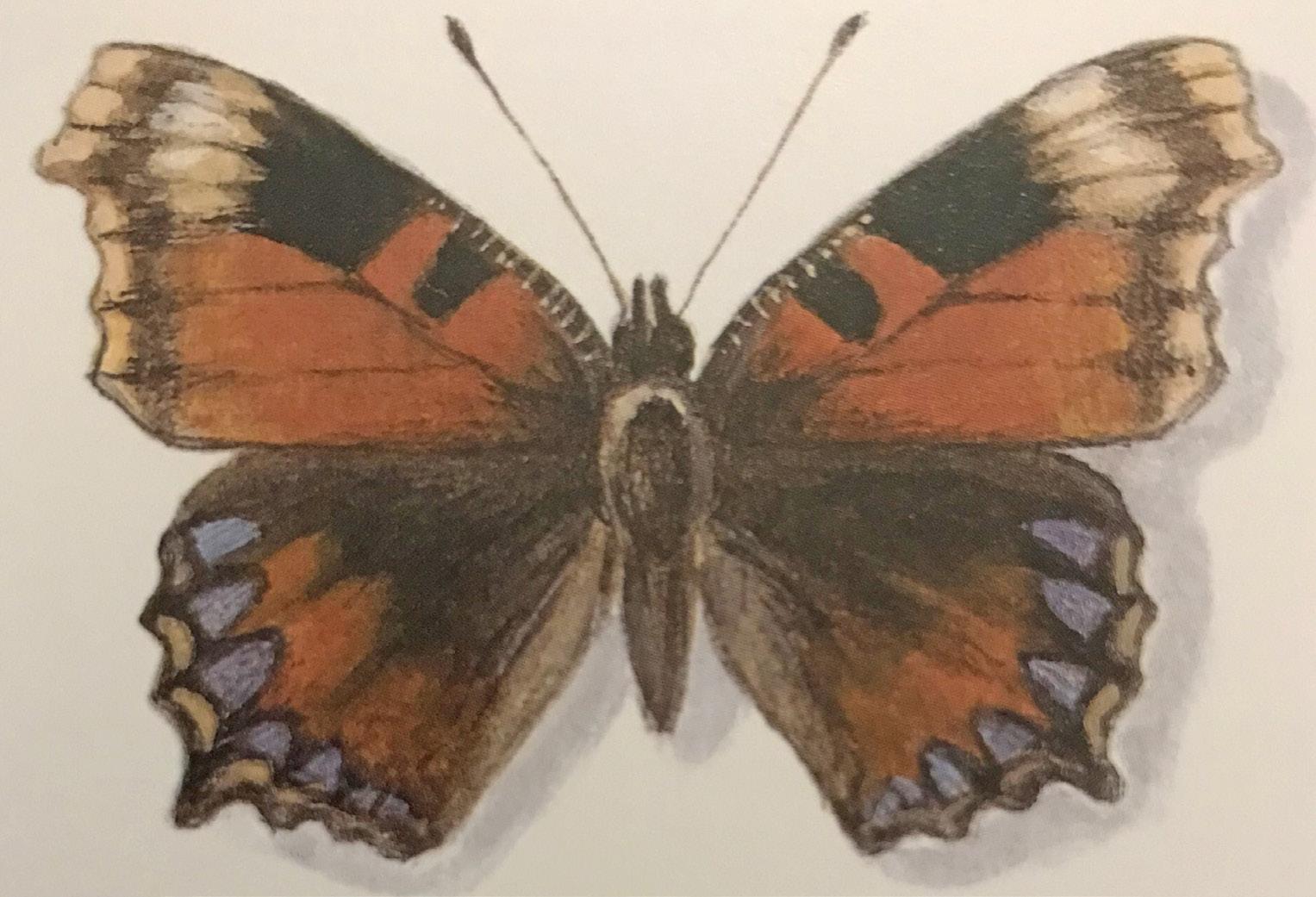
A.S. Harmer found that varying climatic conditions during different stages of butterfly life cycle, can cause aberrant forms. This has been proved in captive breeding tests. I am not sure yet, but it is reasonable to assume that at least some moth species are affected in a similar way.
Diminutive imagoes have been seen more in the last few years too, especially this year (2022). Trevor Goodfellow and Julian Dowding were surveying when they spotted a small Small Tortoiseshell about half the normal size with dull colouration
(see photo page 7). not only that but soon after, they spotted a small Small white of about the same reduced proportion. Elsewhere Common blue, Red Admiral and even some Brown Argus have been seen in smaller form. Harmer states that the male aberration, which shows similar pale patches on the forewings to the one they saw with pale colouration (see photo above), were due to sudden heat shock during early pupal development. Perhaps the reduced size is part of this interruption of their development, or a separate condition is responsible?
Butterfly Conservation, recently received a quarterly donation of £290.95 from AmazonSmile, thanks to customers shopping with Amazon Smile turned ON in the app. or at smile.amazon.co.uk
To date, Amazon has donated a total of: £3,161.17 to Butterfly Conservation.
(BBC Science online)
In 1979 the Large Blue (LB) was declared extinct in Britain.
In the 1980’s, Prof. Thomas led a reintroduction program involving the import of Swedish caterpillars to southern England over the following 10 years.
This Summer, volunteers counted 750,000 LB eggs, potentially leading to an estimated 20,000 adults making it Europe’s largest colony.
Prof. Thomas explains that the success by drawing attention to habitat restoration of over 40 sites in Somerset and the Cotswolds.
Peter Maddison
Roland and Frances Bee have lived at Newsons Farm since 1997 and in the early years of being there planted more than 1500 trees and created what have become wonderfully floriferous wildflower meadows. They are long standing members of Butterfly Conservation and Frances walks a UKBMS Transect on her land. The Suffolk Branch had visited the farm back in 2010, and those of us who had been present on that occasion were particularly keen to see how the farm had developed.
On our arrival Frances and Roland greeted us with refreshments and told us a little of the history of the place and the work they had done. The 15 people who were present divided into two groups and Frances and Roland guided the groups around the farm. 11 species of butterflies were recorded with some quite good numbers of the grassland species with perhaps an additional species, a White–letter Hairstreak being glimpsed as a small butterfly between bramble and elm tree.
The management of the wildflower meadow is interesting and has been honed to work successfully on the heavy clay land. Nearly 20 years ago wildflower seeds germinated and established without too much trouble once the land had been ploughed deeply bringing the low nutrient subsoil to the surface. Now mowing is done in September with a high cut to allow invertebrates to survive. Grass areas are cut on a three-year rotation, which allows Small and Essex Skippers for example, to continue their winter life cycle in the stems of certain grass species. Small mammals thrive in the tussock grass and in turn they provide a food source for barn and tawny owls.
On returning to the farmhouse, we were offered coffee and cake and once we had all compared notes of our additional findings such as four-spot chasers and broad-bodied chasers by the pond, the group thanked our generous hosts and departed.
Lead by Trevor Goodfellow
A calm day with bright sun and 29 degrees centigrade. A quick reconnaissance lap before the start revealed one Purple Emperor (PE) gliding at tree top height and another I nearly stood on which circled me several times as if to land but flew away instead.
10 members were checked in at the entrance to the wood and a leisurely walk along the main track was bleak until a few Silverwashed Fritillaries appeared. Many of the group were getting some close-up photos.
I then led the group past the 2 butterfly meadows, where we encountered 2 more PE, one at tree top height and one which appeared from the ground and flew past everyone at waist height. Although we didn’t find any White Admirals, we saw Purple hairstreak, Large skipper, Large white, Small white, Green-veined white, Peacock, Red admiral, Meadow brown, Ringlet, Gatekeeper, Comma, and male and female Brimstone (12 species).
Many thanks to the members: Pauline, Nick, John, Joe, Derek, Alexese and Bruce, Guy and Pam, Jenny and Mike for their support, a very pleasant walk with such good company (and some banter). Thanks to SWT for approving our members’ event. The illusive PE did not sit for us, but David and Margie Carter sent me a photo taken at Bradfield wood the day before the walk when one landed on David’s boot.
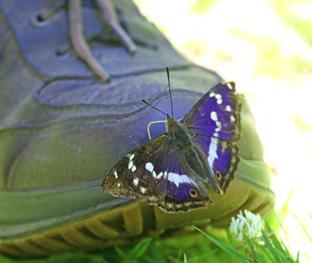
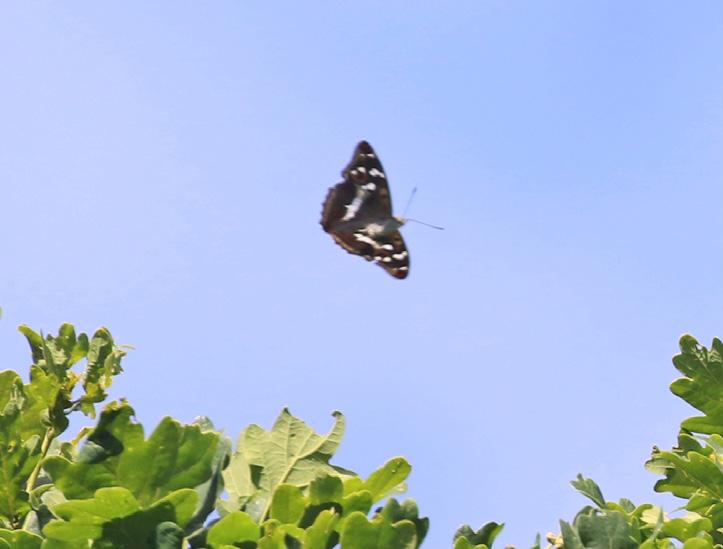

On a second visit on the 14th, I was accompanied by Madelaine, her 4-year-old son Chester and baby daughter Niamh, her
mother and sister Allanagh. Madeline had to withdraw from the Monday organised group walk so I offered a tour during my casual visit. Chester’s first words were ‘did you know butterflies smell through their feet?’ I was impressed with his enthusiasm
as he called out ‘Trevor look, another one’ with each sighting. We noted all the beforementioned species plus Speckled wood and White Admiral but no Brimstone.
Photos: Chester & Trevor and Chester, Allanagh, Niamh & Madelaine by Madelaine


& 16/7/22
Peter Maddison
An appeal to members for suggestions for new walks brought about two new events. These were at Wissett, near Halesworth and at Giffords Hall, Stoke by Nayland.
Led by Chas Keyes, the Wissett walk on the 14th July, took 5 of us along bridleways and quiet country lanes where the expected grass species – Skippers, Gatekeepers, Meadow Browns and the whites were found. It was noted that much of the bramble was already producing fruit, although a few flowering branches were found where butterflies were alighting for nectar. In the heat of the day, our steady walking pace gave us time to attempt to identify Small and Essex Skippers, but like electrons round a nucleus
they wouldn’t stay still. Purple Hairstreaks were a nice find along a short row of oak trees and it was instructive to watch them at treetop level darting between oaks and close by honey-due laden ash trees.
A little further on, Alan Witherby had invited us to visit his home with its 35 acres of woodland and wildflower meadows. A tour of two 7-acre meadows, one of which hadn’t been ploughed for 50 years, was impressive for its huge swathes of yellow rattle, knapweed and tufted vetch, much of which had already formed seeds. The second meadow had been sown with a perennial mix including lucerne and bird’s-foot trefoil, the former holding good numbers of Peacock,
but during our search only 1 Common Blue and 1 Brown Argus were recorded. In all 15 species of butterflies were found, but the abundance of butterflies that would have been seen in previous years was just not evident. Perhaps I’m rushing the season along and the high-summer emergence is yet to come. Our thanks to Chas and Alan for their leading of the walk and hospitality. We’ll be back!
The second new walk on the 16th July at Giffords Hall, Stoke by Nayland, an estate that had not been survey for butterflies, was suggested by Jane Henderson. Permission to walk off the public footpaths was obtained and with the guidance of estate staff an outline route was planned. Wildflower headlands and margins together with a patchwork of interconnecting mixed woodland provided much potential for insect life and other wildlife. In the heat
of the day the butterflies were moving fast, making the identification of even the whites difficult to determine. A male Brimstone was a welcome species for a mid-July count as was the finding by Jane of a White-letter Hairstreak on the last flowering fronds of a bramble. There are many patches of elm, in varying degrees of health, but White-letter hairstreak ought to be secure on the estate. In all 16 species were seen which, considering the extremely hot weather, we were pleased to record, but a Silver-washed Fritillary or White Admiral would have made a pleasing addition - there is potential.
Thank you to our co-leaders for suggesting these walks. If members know of butterfly sites that have been under recorded do let us know, so that we can arrange a recording visit.
Led by Trevor Goodfellow and Rob Parker.
We met at the arranged location at the rear of Pakenham Church. The group consisted of the Vicar (Katherine), Twm, Mark, Rob’s son Chris, and Peter. After the greetings and niceties, we set off towards the wood wondering if we would see anything at all on that windy overcast but warm day. The woodland clearing normally supporting Silver-washed fritillaries and White Admirals was predominantly bramble with berries not flowers, but a few thistle flowers gave sustenance to Gatekeepers and Whites, while Purple hairstreaks occasionally flew
from high in the Oaks. We walked along to the end of the perimeter track to a concrete pad where some butterflies had been seen last year, and we did find a few nectaring on teasel and bramble in the sheltered corner. A total of 10 species were recorded: Peacock, Gatekeeper, Meadow brown, Ringlet, Large white, Small white, Green-veined white, Speckled wood, Common blue and Purple hairstreak. Migrant hawker, Southern hawker, Brown hawker and Ruddy darter (odonata) also noted.
A pleasant walk thankfully no rain. Pity the group was mostly committee members, but thanks to Katherine and Chris for joining us.
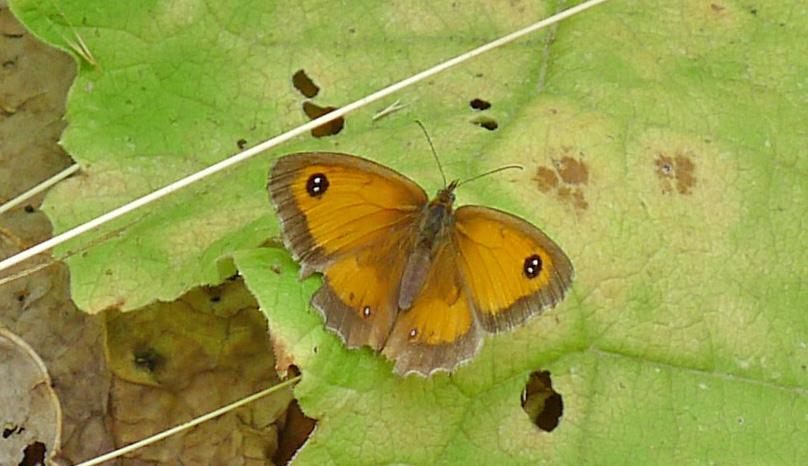

The weather was virtually a repeat of last year’s event with cloudy conditions in the morning and even a short burst of rain. Butterfly numbers were few but there was a rapid acceleration in afternoon sun. The star of the show was undoubtedly the Grayling, landing on visitors, parked cars, the gipsy caravan and chalet, giving good close views of its effective camouflage when at rest. My large group of twenty-four may have seen few butterflies in the morning but instead had good close views of the moths trapped the previous night at different points in Trudie’s garden. Trevor Goodfellow soon had a very interested audience and the look on the faces of young children was a delight. Trevor has included a separate article about these moths. In addition to Grayling we recorded the three whites, Red Admiral, Peacock, Comma, Gatekeeper, Meadow Brown, Holly Blue, Small Copper, Speckled Wood and, after much searching, one Purple Hairstreak in the car park oak. A buzzard was calling distantly, a green woodpecker was yaffling frequently and swallows were flying into the shed close to the BC stall, probably to feed a second brood. Paul Buckle did an excellent job in directing cars and giving details about several questions from my group that I couldn’t answer. Trudie’s grandchildren
made and served delicious refreshments and Peter Maddison, Alan Johnson and AnneMarie Stewart took turns on our BC stall.
Once again, a bee colony, donkeys, sheep, and tortoises added another element to the day’s enjoyment and Trudie is to be thanked for her hospitality and generosity. Donations were £444.69 and this is almost the same total as the profit made so far on the book ‘The Wildlife Garden at Aldeburgh’.
Moth records: (Trevor Goodfellow)
89 species of moths were recorded on the day from 2 home-made Skinner traps and a MV Robinson trap (loaned by Peter Maddison) set up the night before. I must say that the Robinson trap was by far the most productive, but whether that was because of positioning or more effective retention, I cannot be sure. In any case there were hundreds of delightful moths to enthral the visitors. Although adults took a keen interest, young children were captivated by the various hawk moths and Garden Tigers. It was a treat for me that the young people were getting engaged and perhaps their encounters sparked off some long-term interest in Lepidoptera. Thanks to Tony and Sandy Fox for their assistance on the day and for identification and photos.


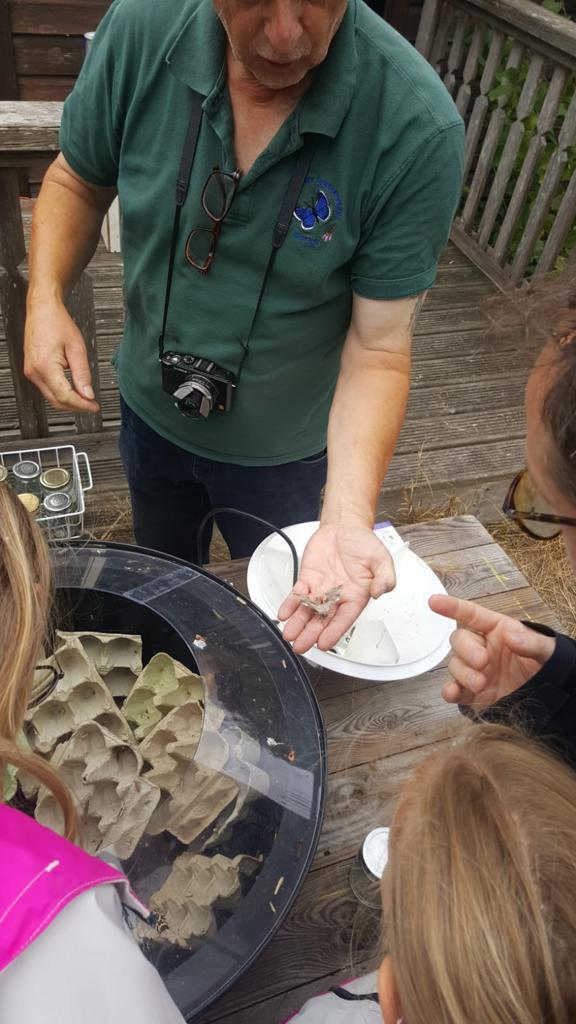

Richard Stewart
I must admit that none of these three is currently among the fifty-nine nectar plants in our present garden. However, phlox was part of a long back border in our last garden, close to a buddleia, Clary and Candy tuft, it became the best part of our garden for visiting butterflies. In the top two hundred ‘Butterfly Plants for The Garden’ which I have mentioned often it was in the top twenty. It attracted twenty-five different species and was the preferred nectar source for Brimstone, Large White, Meadow Brown and Red Admiral.
Privet was also high up on the list, attracting twenty-four species and being the preferred nectar source for Comma, Gatekeeper, Meadow Brown, Red Admiral, and Speckled Wood. Although it is usually found in hedging my garden encyclopaedia refers to ‘the scent of its flowers in summer’ adding
that ‘it also withstands urban pollution and will grow almost anywhere’. Presumably that also included salt spray from the sea as one well visited by insects grows along the path at the Orford end of Shingle Street.
We have never grown Purple loosestrife as it needs a good-sized pond or bog garden to thrive. It was introduced in North America and Canada where it has become an obstacle in some waterways, obviously lacking the restricting factors present in our country and I have never seen this plant in any density or invasive nature. My main memory is seeing one in a sunlit position attracting many butterflies in the extensive gardens at Somerleyton Hall. Most were ‘whites’ and it is the preferred nectar sources for Large and Small White butterflies. It also came high up on the top two hundred list, attracting twenty different species.
Trevor Goodfellow
During various butterfly surveys this year I have seen more highfliers than in 2021 (Purple hairstreaks (PH), White-letter hairstreaks (WLH) and Purple Emperors (PE)).
I finally tracked down PH at Burgh House Farm (to the delight of the owner Bill Mayne who is a keen member of SBC), and private woodland near Hadleigh. I also
verified WLH were still at a private wood on Rougham Estate, and found several WLH in Elms and 20+ PH around Thurston (no WLH spotted last year).
Regular visits to SWT Bradfield wood resulted in many sightings of PH and PE although mostly skyward, some did come to ground.
Unfortunately, one’s neck does suffer with
all that looking up, and the consequences of that is tripping over some things and stepping in others. Though when you get rewarded with some butterflies’ aerial displays, it is worth it.
At home this year, I have been very fortunate to see a Clouded yellow, White Admiral, Silver-washed fritillary, Hornet moth, Lunar Hornet moth and 6-belted clearwing. All quite thrilling, reminding me that ‘seek and ye shall find’ and ‘sometimes you get
lucky’ even if you are not ‘seeking’. It has apparently been a good year for Clouded yellows and Hummingbird hawk moths.
Elsewhere I found Forester moth, and other moths of note like Downland bell - Rhopobota stagnana, Fern smutPsychoides filicivora, and Orange conchCommophila aeneana. I apologise if this all sounds like bragging but, I have a trumpet so I will blow it. I hope you all had a great season too.
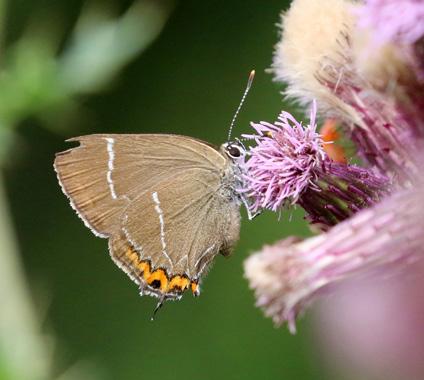

Tomlinson
I don’t know what it is about purple emperors, but they are one of those butterflies that people clearly become obsessed with. If you don’t believe me, then turn to Matthew Oates’s book, His Imperial Majesty. It features more than 400 pages detailing its author’s fascination with this splendid butterfly. His knowledge of emperors is clearly unrivalled, and I’m
sure he can remember all of his numerous encounters with this charismatic species. Another person obsessed with the emperor was the writer D.J. Watkins-Pitchford (he wrote under the pen name of BB). He used to refer to the Emperor in his articles as his “beloved Iris” (the Latin name is Aptura iris), rearing the larvae in a muslin cage in his garden, then releasing the adults in nearby
Rockingham Forest, where they can still be found today. I met BB just once, not long before his death, but when he heard of my interest in Emperors, he proudly showed me his larvae. I met BB through a mutual friend, Bob Gent. A few years later, on a bright July day, Bob took me to Rockingham to try and see BB’s emperors. We were successful, and I have a vivid recollection of seeing seven of them that day. They were, if I recall, quite easy to find, but it was long before digital cameras, and I didn’t have a suitable camera with me to record such a memorable day. They weren’t my first emperors, as I had seen one in 1989 when I had been taken to see young red kites, ready for release, in a secluded but mature deciduous wood in the Chilterns. They are, of course, one of those secretive butterflies that are often overlooked, flourishing in woods where nobody ever searches for them. When I lived in Kent, I used to hear occasional reports of possible or even probable Purple Emperors in the woods around Toys Hill, Westerham, a National Trust property. It took me some years before I eventually saw one, but it was the only one I ever saw there, despite numerous attempts to try and find another. I have seen them abroad. On a summer visit to La Perche, a rural area in north-west France filled with woods and meadows grazed by Harlequin-spotted Normande cows I expected to find an abundance of butterflies. I didn’t, alas, but I did get a great view of an emperor, sunning himself on an oak tree, the flashes in his purple wings catching the sun. He was the only I saw. I’ve looked for them in Bulgaria, too, but without success
- I suspect that I was there a little too early. However, there were compensations in the form of spectacular poplar admirals, a velvety-black butterfly that’s even bigger than an emperor and just as exciting to see. I did see Freyer’s purple Emperor in Bulgaria, a rare and local species that is restricted to the Balkans, along with both Hungarian and common gliders. I’m embarrassed to say that until this past summer, I had never seen a Suffolk emperor, chiefly because I had never looked. On a sunny morning in early July, I set off for Bradfield Woods, arriving at 10am more in hope than expectation. Ten minutes later, and only a few hundred yards into the woods, an emperor flew past me at eye level, surprising me sufficiently to mistake it at first for a White admiral. It disappeared as suddenly as it had appeared, so I walked on. Around the next corner I found another Emperor, but this one was far more co-operative, flitting around me a few times before finally landing on the path. With its wings shut he was almost impossible to spot, but he was generous enough to not only remain in the same place for many minutes, but to open his wings every now and again to give me a flash of purple. I never managed to achieve a photograph of both wings flashing purple at once, but I was quite happy with what I did get. I even managed to show him to two other people looking for butterflies, as well as a couple walking their Cocker spaniel. I think they were impressed, though the spaniel didn’t give it a glance. Eventually the emperor became bored with sucking the salts from the path, taking off for a quick
patrol of his territory. He soon came back, and this time decided that my hat would make a fine perch, where he remained for 10 minutes. A couple came along the path looking for Emperors and asked me whether I’d seen one. I told them to look at my hat. Remarkably, another male Emperor appeared, and this one landed on my shorts. Two emperors at once: I was honoured. A
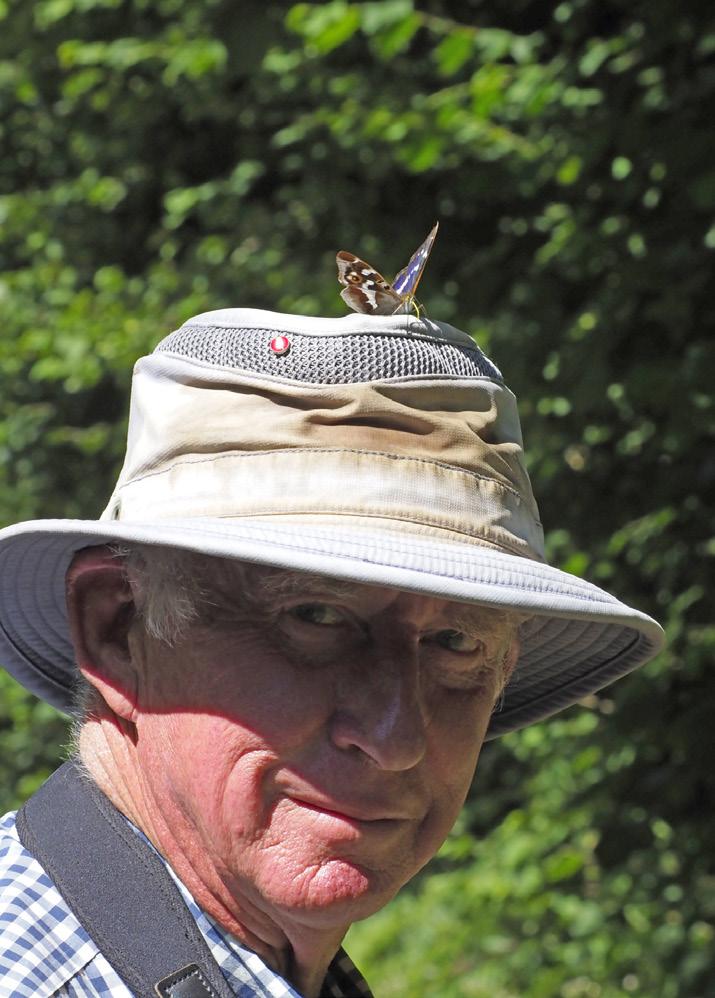
week later, buoyed by my previous success, I took a friend to look for the emperors. We didn’t get as much as glimpse, but he did enjoy the abundance of Silver-washed fritillaries, plus a strong supporting cast of other woodland butterflies, so the visit wasn’t a failure, even if His Imperial Majesty didn’t grant us an audience. Next year, perhaps.
Purple Emperor by David Tomlinson
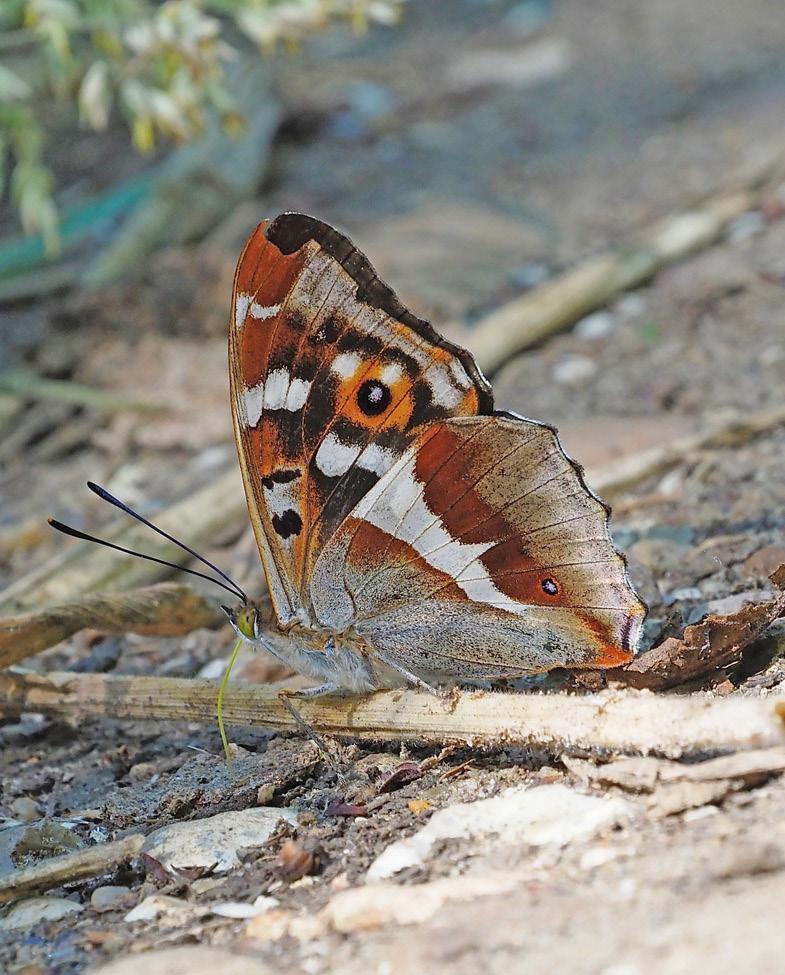
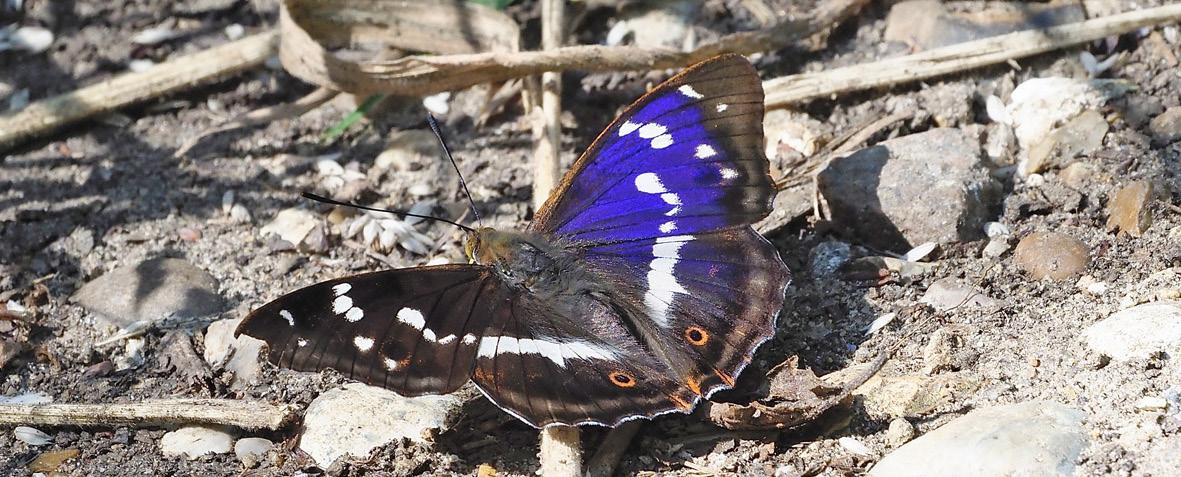
Sandra Holmes
I was interested in Jane Leng’s article in issue 84 as I too have been studying the caterpillars of the Orange Tip butterfly for several years. Beside the information I need for my research in the Phryxe parasite, I also keep other records, like date of collection, and food plant. This year (2022) has been a particularly poor year both in terms of timing and quantity: rather late and not very many, despite my best efforts, in 2020
Nick Amor
As a young child I was fascinated by butterflies. With a slightly older friend I used to chase them, net in hand, in the fields around our new housing estate. My friend chloroformed and mounted them in his display case, but I am pleased to say that I always let mine go. Nearly, sixty years later I was inspired by my daughter Rosalind (who inspires so much of my interest in nature) to take up butterfly chasing again, this time with rather ancient Lumix camera and iPhone 6. My first grandchild, Arthur, was born in April and lives with my son and daughter-in-law in California, so I determined to put together a portfolio of photographs to remind him of his British background – Arthur’s Big Book of British Butterflies. I would need to snap at least twenty different species to fill the book, and as the summer draws to a close I now have twenty-four.
My journey started in early June at NWT
I found 10 caterpillars between the 3rd and 15th of June on both Garlic Mustard and Honesty, compared with:
2021 - 12 between 7th and 13th June
2022 - I struggled to find only 5 between 15th and 29th June
Could the Spring climate be a factor perhaps? (see ECEs article page 6, ed.)
Hickling Broad where I realized a life-long ambition to see a Swallowtail (see below). The beautiful creature sat posing on a long stem of grass for what seemed like hours – I almost cried. Another four or five fluttered in the background. I live close to SWT Bradfield Wood, and this has become a favourite haunt.
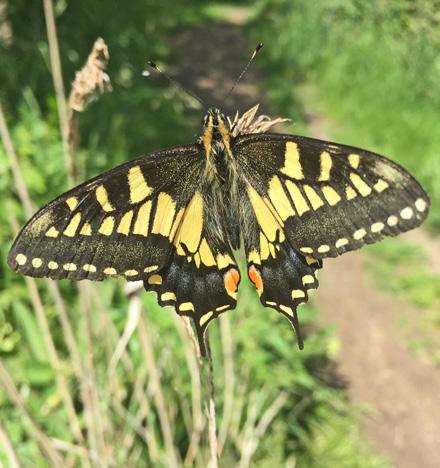
During these extraordinarily hot summer days a walk under the trees has been a real tonic. Silver-washed Fritillaries have been abundant, but I have also spotted White Admirals (see below) and the very occasional Purple Emperor. Sadly, his/her majesty has so far evaded my lens, but there is always next year.
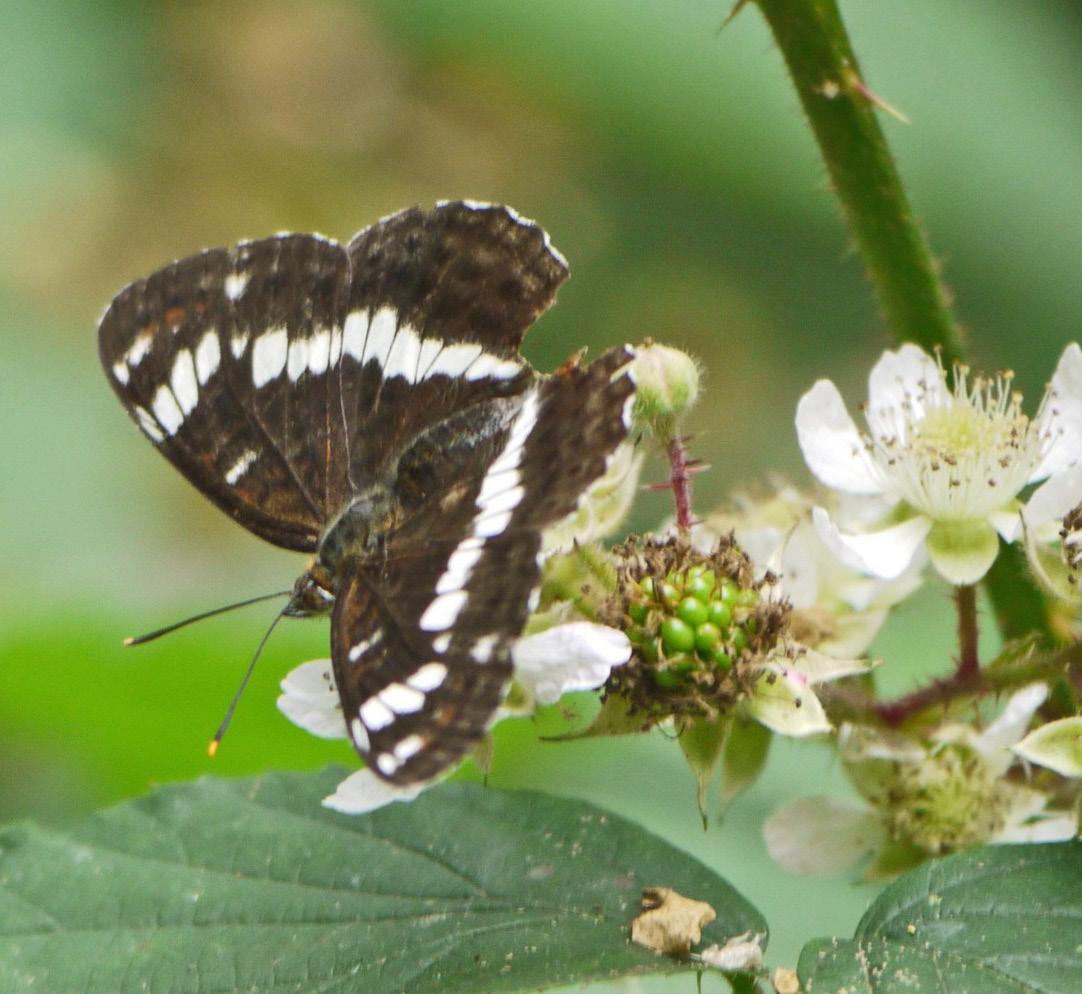
A friend suggested a trip to Devil’s Dyke. On my first visit, to the Racecourse end, I was surrounded by Chalkhill Blues, and on my second, this time to Burwell Cut, by Common Blues. While at Burwell I was enchanted by Clouded Yellows and chased up and down for a photo of one (see top right). Anyone watching me might well have been concerned about my sanity. Most recently I have ventured to the east coast of our own county, spotting Wall Browns at Carlton Marshes (see right), and Grayling and Brown Argus at Theberton Wood. I still make elementary errors, mistaking a Small White for a Large one and a Meadow Brown for a Small Heath, but Rosalind is always there to set me right.
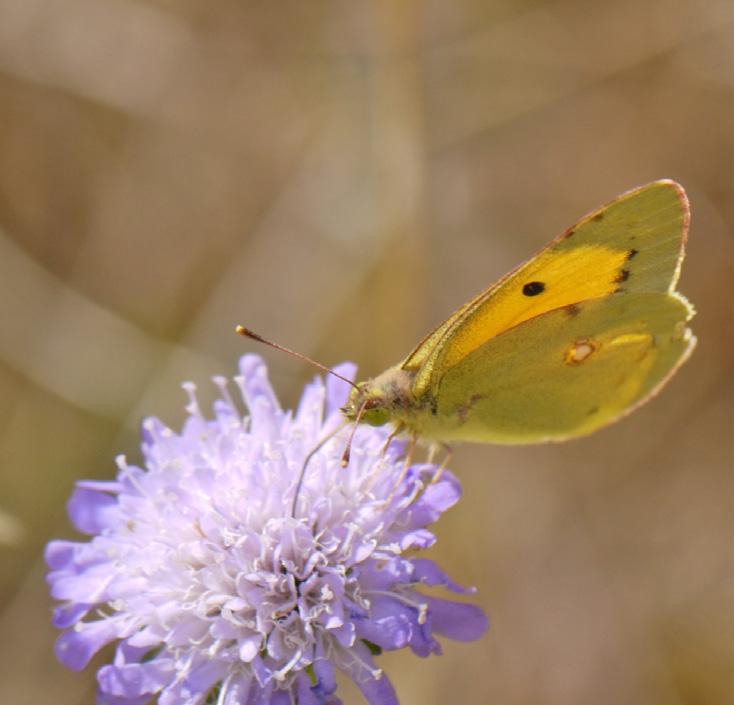

During a WhatsApp call with my son Benjamin, I was once again enthusing about butterflies when he asked a characteristically pertinent question. If you know where to look and when to look, can you find most species? Older hands will no doubt warn me to expect occasional disappointments, but so far, the answer seems to be ‘yes’, albeit with patience, which is not usually my strong suit. My success is attributable to two good reasons. One is the volume of
material, both in print and online, pointing you in the right direction – Butterfly Conservation and Suffolk’s own sightings web page are particularly helpful. The other is those fellow enthusiasts who you meet on site who are invariably ready to chat, share
their expertise and tell you where to go to see the rarities. In an era of climate change and pandemic it is tempting to despair, but the kindness of strangers can restore your faith in the future of our own species.
Kevin Ling
A butterfly I have long wanted to observe in detail is the Duke of Burgundy. A previous trip to Bedfordshire some years ago, had been thwarted by weather upon arrival. So, on 8th May 2022, I finally made it my mission to re-visit. Given that this species is not found in Suffolk and remains one of our most endangered butterflies, my trip was long overdue.
With the prospect of decent weather, fellow BC (and now committee) member Mark Brewster and I set off for the Dunstable Downs. As we neared the National Trust Visitors Centre and car park, a bank of thick cloud had rolled in. Unperturbed, Mark and I set off to our location of Bison Hill. This is a chalk escarpment that runs SW to NE along the downs, affording some amazing views over the Bedfordshire countryside.
Once familiar in coppiced woodland, where its larval foodplant Cowslip was allowed to flourish, the Duke of Burgundy, suffered a sharp decline in suitably managed areas has led to switch its preference to favour low scrubby grassland on chalky banks. This location fitted the bill perfectly. As soon as we arrived at the now closed Bison
Hill car park, the clouds gave way to blue skies and warm sunshine and as if on cue, our first ‘Duke’ was spotted. There was an abundance of Cowslip in flower, however the ‘Dukes’ favour neighbouring scrubby plants, where the males perch, waiting for a passing female. Mark and I both commented on how small and delicate this butterfly is, with a wingspan measuring just 30mm. But what a beautiful species it is, with its rich orange and brown markings on the upperside and striking bands of white markings on the underside.
Our next species to be seen was Green Hairstreak. We had never seen so many in one location. Our count would top twenty by the end of the day. What was unusual was the number that favoured ground level as opposed to perching in bushes such as Hawthorn or Buckthorn. This was a trend that I would see at other sites in Suffolk this spring too.
By now the sun was beating down on Mark and me, with more species making an appearance, including Orange-Tip and Brimstone. However, it was the growing number of ‘Dukes’ that caught our attention
most and in no time, we had observed and photographed several examples (See photo below)

Shortly afterwards we saw the first of twenty plus Dingy Skippers. As nondescript as this species might be compared to others, I have always thought that its name does not do justice to this fine butterfly, especially when freshly emerged, when it has a distinct mix of brown shades and a dusting of white markings. It’s stronghold in Suffolk is Kings Forest, but other than that you need to travel out of county to see them. It was therefore a welcome addition to our day. We mainly found them on the sheltered banks where their larval foodplant, Birds Foot Trefoil was present. Distinguishing them in flight from other day flying moths was a constant challenge, but when at rest they are unmistakable
Mark and I were joined by a local lepidopterist called Peter (who ironically had moved to Bedfordshire from Suffolk). He gave us the low down on the area and introduced us to some quieter paths further down the hill where we might find our other target species for the day, the Grizzled Skipper. Like other spring species, it is only on the wing for a short period each year, spending about 8 months as a chrysalis. Due
to its size and speed, it can also be a tricky butterfly to see in flight, just like the Dingy Skipper. Managing to see one stopping to feed or warm itself in the sun, might be your best chance of closer examination. However, we were lucky on this path and found three ‘Grizzlies’, patrolling rapidly back and forth, with occasional stops along the way (see photo below). This is an attractive species with dark brown wings and white markings on the upperside and outer wing margins.
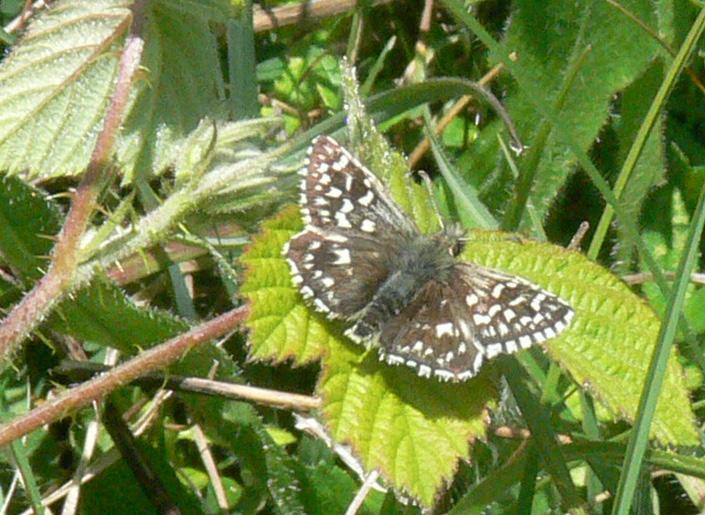
As the day moved on, we enjoyed many more Duke of Burgundy and our total count would exceed forty. To get up close and personal to this species was a real treat and well worth the wait.
Our final objective of the day was to return to the car via the visitor centre, where a cup of tea and fruit scone had our names on it. We spent the last few moments of our trip soaking up the views and reflecting on what had been a memorable day. This is a location that I cannot recommend highly enough and being within a comfortable distance from Suffolk, makes it a great day trip. My thanks to Mark for his wonderful company too.
Jane Henderson
On 19 July, the hottest day ever in the UK, I thought it might be interesting to go to some woodland and see how the heat was affecting the butterflies. I hoped I might learn something. James and I set off to somewhere we knew Purple Hairstreak and White Admiral occur and found that the Purple Hairstreaks were very much in evidence trying to cool down away from the treetops. There were dozens of them, so it was a wonderful photo opportunity although, having said that, they were nearly all in the shade. There were groups of maybe 10 or 12 on the ground which flew up as we walked along, while others, either singles or small gatherings were resting on the vegetation. I counted 7 on one bramble
plant about 2 feet wide whereas on other occasions we’ve been to this wood we have only seen a handful of them.
On viewing my photos later, I found one Purple Hairstreak that had its wings in the wrong position, ie on the underside the forewings covered the hindwings so that more of the pattern on the forewing underside than normal could be seen. Whether it had somehow got them crossed over I don’t know but I don’t think I’ve ever seen this arrangement before although I have heard of it happening occasionally. I have queried this with one of our leading lepidopterists who thinks that this anomaly may be the result of trauma. The markings also appear slightly different from normal with the pale band on the hindwing underside thicker than usual, and according to The British Butterfly Aberrations site this looks like the ab translatefasciata.

Also of interest was a White Admiral which landed on duckweed to get moisture from a pond. Last good thing was one Purple Emperor which came down to the ground for a short while. So, all in all, a good day well spent.
Trevor Goodfellow
At home in Thurston, I have kept rainfall records since 2014 and I found it interesting that June has been both the driest and the wettest month during this time.
Although there are no obvious trends appearing over the relatively short duration of these records, extremes are certainly becoming clear. Another revelation is that the arid months of April and June are key months for plant growth and as April seems to be the driest month of the year,
this could be an important factor in plant development and subsequent lepidoptera larval development. Those plants with taproots like Yarrow and Wild carrot fare better drought conditions than others with shallow roots like grasses.
Here are some graphs showing rainfall in millimetres, see how these months are getting drier. Other months are fairly random, and any trends appear less obvious.
Although there are no obvious trends appearing over the relatively short duration of these records, extremes are certainly becoming clear. Another revelation is that the arid months of April and June are key months for plant growth and as April seems to be the driest month of the year, this could be an important factor in plant development and subsequent lepidoptera larval development. Those plants with taproots like Yarrow and Wild carrot fare better drought conditions than others with shallow roots like grasses
Here are some graphs showing rainfall in millimetres, see how these months are getting drier. Other months are fairly random, and any trends appear less obvious.
Although there are no obvious trends appearing over the relatively short duration of these records, extremes are certainly becoming clear. Another revelation is that the arid months of April and June are key months for plant growth and as April seems to be the driest month of the year, this could be an important factor in plant development and subsequent lepidoptera larval development. Those plants with taproots like Yarrow and Wild carrot fare better drought conditions than others with shallow roots like grasses
Here are some graphs showing rainfall in millimetres, see how these months are getting drier. Other months are fairly random, and any trends appear less obvious.
The table below shows monthly rainfall and monthly/annual averages in millimetres over the entire recording period. I invite you to compare the 2022 records with the average. These figures clearly display the extent of the recent drought.
The table below shows monthly rainfall and monthly/annual averages in millimetres over the entire recording period. I invite you to compare the 2022 records with the average. These figures clearly display the extent of the recent drought.
The table below shows monthly rainfall and monthly/annual averages in millimetres over the entire recording period. I invite you to compare the 2022 records with the average. These figures clearly display the extent of the recent drought.
I have temperature and wind records too, since I renewed my weather station for a better one that connects to my PC This allows me to save the data as an Excel spreadsheet Being ‘old school’, I tend to work with simplified data manually for charts and leave the detailed data in spreadsheet form that the weather station provides. This is a customisable daily recording duration which I set to record at 2-hour intervals.
Interesting that we get about 500 to 600mm of rain each year yet the recent Australian deluge was 652mm in 24hrs! and all that followed 17mm for the whole of the previous month. In August, some long awaited rain amounted to only 12mm while 3 miles away, Bury St. Edmunds had 76mm and 10 miles away, Kentford had 110mm on the same day (that is more than I had in the last 6 months).
I have temperature and wind records too, since I renewed my weather station for a better one that connects to my PC. This allows me to save the data as an Excel spreadsheet. Being ‘old school’, I tend to work with simplified data manually for charts and leave the detailed data in spreadsheet form that the weather station provides. This is a customisable daily recording duration which I set to record at 2-hour intervals.
Interesting that we get about 500 to 600mm of rain each year yet the recent Australian deluge was 652mm in 24hrs! and all that followed 17mm for the whole of the previous month.
In August, some long awaited rain amounted to only 12mm while 3 miles away, Bury St. Edmunds had 76mm and 10 miles away, Kentford had 110mm on the same day (that is more than I had in the last 6 months).
Looking at rainfall on its own is just part of the picture. As I am writing this, I watch the outside temperature climbing over 34 degrees Centigrade to a maximum 37 C. This has a massive effect on wildlife and particularly plants. Butterfly foodplants may wither and die in these hot dry spells, not to mention the effects of wildfires.
I wonder if nature has an answer for this problem?
Mike
Taylor & Chris Hainsworth ( Brecklandnnr@naturalengland.org.uk )
Cavenham Heath in 2012 by Twm Wade
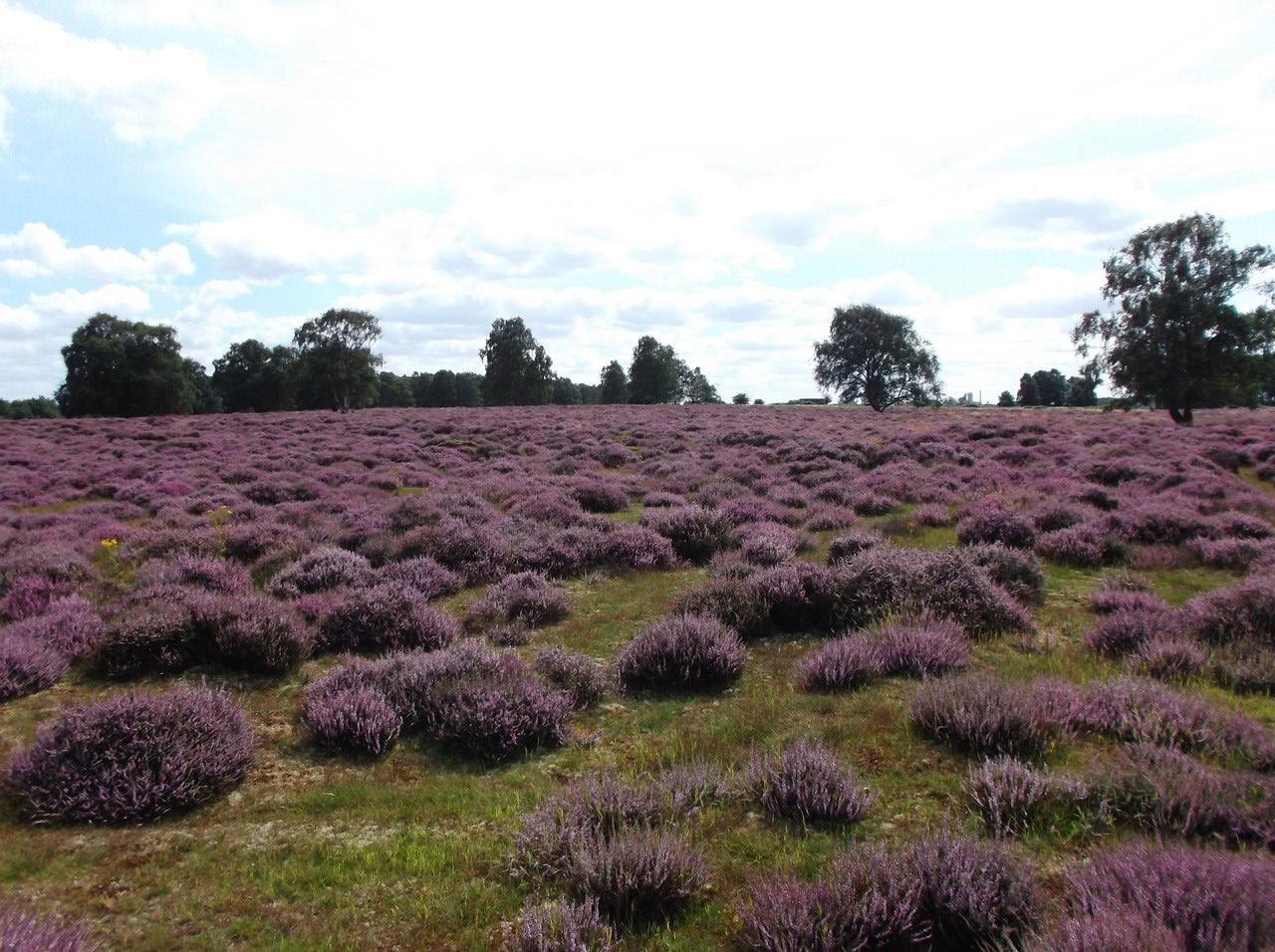
Cavenham heath NNR, near Mildenhall, is a classic Breckland heath, with large areas of acid grassland, heather heath and Silver birch woodland. Natural England manage
the site and we have been undertaking a Butterfly transect on site for over 20 years. We assume that heathland wildlife can tolerate and even thrive in hot, drought prone, hard grazed, windswept environments but is this correct? Many Climate Change predictions suggest a shift to wetter, milder winters with hotter more droughty summers so maybe this weather will become the norm, we wonder what impact this will have on the site’s wildlife and especially its butterflies.
Late summer usually gives us a spectacular carpet of purple as the heather comes into
flower providing a valuable nectar resource, but this year it has really struggled with lots of plants look sickly and scorched and some dying. Even Ragwort, a popular food plant with butterflies and other invertebrates seems to have had a much-shortened season. In the woodland many trees have been stressed, with leaves turning brown and dropping prematurely. Bramble, normally a very robust plant, has been shrivelling up due to the lack of moisture.
This year’s weather has undoubtedly had a major impact on the butterflies. The early spring was quite cool and changeable, and we struggled to find days for the weekly transects. From early summer the weather improved to become warmer and staying fine. It was looking like a great English summer and shaping up to be our best year for overall butterfly abundance since we set up the transect in 2002. Although even in a good year, there are winners and losers: Small Tortoiseshell, Peacock and Comma all did very well, along with Gatekeeper, Meadow Brown and Ringlet. Large Skipper had its best year to date with annual index of 203.
On the downside, the cool spring resulted in Orange Tips having a poor year. Also having a poor year were Brown Argus, Common Blue and Small White which were well below average and Small Heath numbers rather low too. But as the season progressed through July the dry period turned to a drought, the heath turned a crispy golden parched brown and butterfly numbers on the transect dropped rapidly and massively.
Two species are a concern the Small Copper and Grayling. Grayling has a small but relatively stable population with an annual index of 20, but in 2019 another extremely dry July and August, we did not record a single Grayling in that year. In 2020 we had no records and feared that our small population had died out, so we were very relieved to see a few individuals in 2021. Unfortunately, this year’s drought and high temperature have knocked it back again with no individuals recorded. We wonder if the population is resilient enough to bounce back again. Small Copper is normally one of our most abundant butterfly species and Cavenham is one of the best sites on UKBMS for Small Copper in the country. But 2022 has been its worst ever season by some margin. The records show 2019 was one of its best years with an annual index of 1042 but this year with 3 weeks left we have only recorded 112 individuals! But our main concern is across all species as to the impact of the drought may have next year, because so much of the vegetation is scorched –we worry that the caterpillars that would make up next year’s populations which should have been munching on grasses like Yorkshire fog, Sheep’s Sorrel or Bird’s-foottrefoil may have simply perished as their food plants withered away to nothing. As the 2022 season comes to an end we watch with interest and a little trepidation on what effect the exceptional conditions may have on butterfly numbers and species diversity on the NNR in 2023 and in the longer term. ( Brecklandnnr@naturalengland.org.uk )
In June 2022, Malcom Taylor had a nice surprise while fishing: ‘I had to help these 2 beauties out of the fishing lodge at Birch Pool Retreat in France’ says Malcom, ‘the first time I have seen a Large Tortoiseshell there’ he added.
Silver-washed fritillary and Large Tortoiseshell by Malcom Taylor
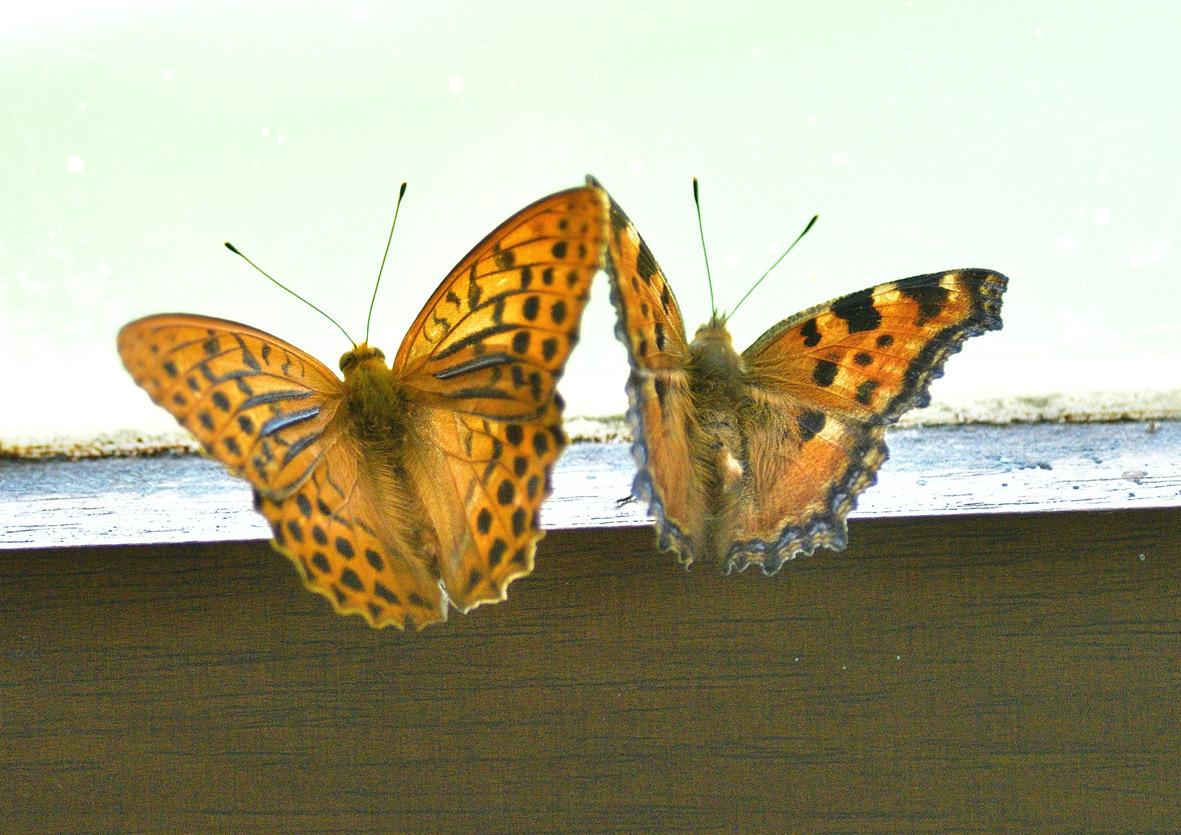
Snippet New Scientist Magazine

Two atomic clocks have been connected using quantum entanglement, a property that intrinsically links them so that changes in one will instantaneously affect the other. The connection could be used to make more accurate measurements of dark matter and gravity.

Trevor Goodfellow
I received a request for a moth trap loan by email and at first thought it was another of those dodgy emails. After further investigation, I concluded it was a genuine request.
Although the applicant was a non-member, they were a worthy cause.
I rang Emily who clarified my concerns and explained that they were ‘Achieving Aspirations’, an organisation that helps young adults 16 – 30 years old with learning disabilities, autism, and complex needs.
I chose to deliver the actinic trap along with UV safety glasses and instructions etc. and explained to Emily and Nikki how it worked and gave them some advice on where and when to use it.
After setting up a few times in their urban wildlife garden, only two moths were caught (Vine’s rustic and Heart and dart see photos below.) but they said it was a useful interest for the students and they enjoyed the anticipation of opening the trap in the mornings.

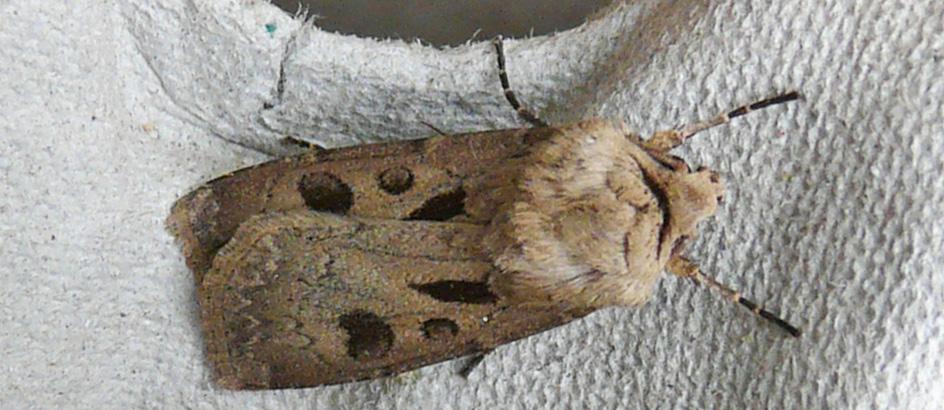

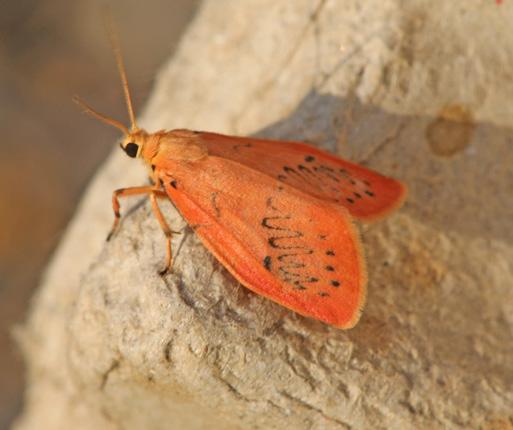
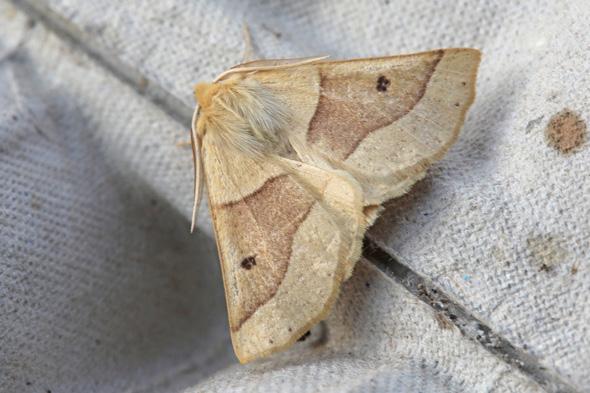
One of the more fruitful moth trapping nights this year so far, at home in Thurston, despite a heatwave and virtually a full moon, there were hundreds of moths greeting me the next morning.
I used the MV Robinson trap, which is the best for the job and as I have no neighbours nearby to annoy, it suits me.
Although there were no hawk moths this time, several docile wasps required careful attention. A few moths were happy sitting on the outside of the trap, and a Black arches which I saw enter the trap late evening, was not there, so retention is an issue. A good selection of species ranging from the bland to the striking and all took a while to identify and list. I could identify most of them but as usual I needed the help of a good book to refer to. In fact, I used both the 3rd edition British & Irish Moths by Chris Manly which covers all species, and the Field Guide to the Micro Moths of Great Britain & Ireland
& Ireland illustrated by Richard Lewington as a
for those tiny ones. A list of the species is shown below with a mixture of common and Latin names, sorry. Previously, I even Ringlet butterfly in the trap! Often caddis flies and chafer beetles are drawn to light and sometimes dragonflies beetles and burying beetles
Insert photos: catoptria, scalloped oak, and rosy footman
1 acleris comariana/laterana 30 lesser broad-bordered yellow underwing 2 anania coronata
chrysoteuchia culmella
rosy footman
dusky sallow
I have a running total of around 730 species including a handful that are unverified (requiring dissection), all recorded at home in much the same spot in a large garden since 2012. Annually I get an average of 350 species, 20 of which are new to the list. Records are uploaded to the Suffolk Moths website where they are verified by the county recorder. Personally, I am not normally interested in genitalia dissection to prove a moth’s identity where species look identical, but I understand that in some circumstances it
will reveal useful information. The growing, long list of species has been expanded since I started identifying micro moths. For a novice, the problem is that some micros are so small (no surprise there) and look similar e.g., leaf miners. Although I am still learning, I can normally place a species into a family, which speeds up identification, but I still have to look them up each year as I struggle remembering a lot of them. Well done to those SMG recorders who have a broader species knowledge.

Brimstone has a characteristic ‘leaf’ shaped wing as opposed to the Clouded yellow rounded wing and in flight the Clouded yellow normally appears a darker yellow with visible black wing markings. Female Brimstones are paler and can be overlooked as ‘Whites’. Brown Argus is usually identified by its small size. The female
Brimstone has a characteristic ‘leaf’ shaped wing as opposed to the Clouded yellow rounded wing and in flight the Clouded yellow normally appears a darker yellow with visible black wing markings. Female Brimstones are paler and can be overlooked as ‘Whites’. Brown Argus is usually identified by its small size. The female Common blue with open wings shows border and white spots and a blue tinge near the body and sometimes extensive blue wings will help i.d. Underside view: although the spots can vary a lot, the Brown Argus has a diagnostic ‘colon’ mark where it appears that one spot is out of alignment.
Common blue with open wings shows border and white spots and a blue tinge near the body and sometimes extensive blue wings will help i.d. Underside view: although the spots can vary a lot, the Brown Argus has a diagnostic ‘colon’ mark where it appears that one spot is out of alignment.
10-Gatekeeper
9-Meadow Brown
8-Purple Emperor
7-Swallowtail